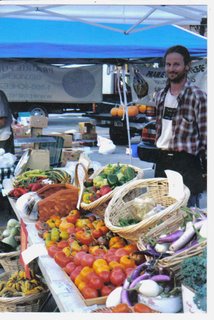30 mar 06
Last Monday my uncle and I made the 2nd planting of peas (Oregon Giant and Sugar Ann), 1st planting of kale, lettuce, radishes, spinach, chard, bunching onions, ...I forgot the beet seeds at home. We are using the stick seeder from Johny’s for our larger seeds such as peas. You have to watch it doesn’t jam and that the seed is feeding but so far, so good. I think it will be especially useful when I am doing long rows of corn.
This week I’m told again how crazy I am to try growing vegetables without tilling. I’m told I will fail miserably and what I need to do is get a tractor out there to till it. Except where I worked the ground with a fork for garlic and flower bulbs last fall, I have not done anything to the soil except rake back the corn litter. The soil is loose and I can make a furrow with a hoe very easily. I will use the fork or broadfork for some other crops as well but no heavy equipment.
I can see a lot of the finer parts of corn litter mixed in the top layer. I used the stick planter to plant some peas right through the litter. I think all those husks and cobs might make good mulch. Last year's stubble works to my advantage forming nice 30" rows and paths the whole length of the fields.
The ground to me looks superb but I suspect it has problems from years of conventional farming. I left the corn stubble and litter in the field all winter. Some farmers do that but most seem to plough in the fall. When the fields are ploughed it directly exposes a lot of the topsoil to the sun, wind and rain causing drying and erosion. I’m reminded of the topsoil sometimes seen clinging to snow drifts along fields in winter. Many microorganisms that thrived several inches below ground are also exposed to the surface elements along with the soil.
In contrast, the unploughed fields appear yellow with all the corn litter and the dark soil is scarcely visible through it. Soil macro-organisms such as worms seem to prefer this type of buffer between them and the elements. Indeed, as I raked back the corn litter to plant seed, I noticed several worm tunnels. The stubble holds the soil in place and the husks and other litter shield the soil from the elements.
